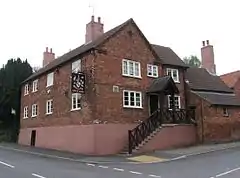Eakring
Eakring is a village and civil parish in the Newark and Sherwood district of Nottinghamshire, England. Its population at the 2011 Census was 419.[2] There was sizeable oil production there in the mid-20th century.
| Eakring | |
|---|---|
 Eakring – Savile Arms | |
 Eakring Location within Nottinghamshire | |
| Population | 395 (2001)[1] |
| OS grid reference | SK673623 |
| District | |
| Shire county | |
| Region | |
| Country | England |
| Sovereign state | United Kingdom |
| Post town | NEWARK |
| Postcode district | NG22 |
| Dialling code | 01623 |
| Police | Nottinghamshire |
| Fire | Nottinghamshire |
| Ambulance | East Midlands |
| UK Parliament | |
Geography
The village lies between the A617[3] and the A616 roads between Ollerton and Southwell. Dukes Wood to the south is situated on the top of an escarpment, giving good views over the Trent valley to the east and towards Southwell to the south. Clouds formed by the Cottam Power Station are often seen on clear days to the north-east. A steep hill descends into the village from the south, on which the road passes a large residential training centre for National Grid plc.[4]
Heritage
The village pub is the Savile Arms in Bilsthorpe Road. The Robin Hood Way, a long-distance footpath that passes through the village, is altogether 168 km (104 miles) long.
Eakring Mill was a five-storey brick tower windmill, built some time after 1840 (grid reference SK673628). The sails were removed in 1912 and the mill was derelict by 1936. It was converted into a house in about 1995.[5] A windmill was shown on a map of 1832, located in Mill Hill Field, where two footpaths cross, (grid reference SK668616) and another windmill shown north of Eakring Brail Wood (grid reference SK662614).
The parish church[6] is dedicated to St Andrew, the Apostle. The grade II* listed building was constructed in the 13th–15th centuries and restored in the early 1880s, when the seating was replaced. It contains a font bearing the date 1674, and a plaque commemorating the installation of the tower clock in 1887.[7]
When Gilbert Michell was Rector in the earlier 18th century, the Tudor parsonage house (now the Old Rectory) was the largest house in the village. It "came with a large tithe barn and other outbuildings, a fold for animals, and a neighbouring orchard and two fish ponds described as 'pleasure grounds' for the house."[8]
Notable people
In birth order:
- Reverend William Mompesson, vicar of Eyam during the Plague in 1666, moved to the village in 1670, lived there for 39 years, and was buried in the churchyard.
- John Michell (1724–1793), Eakring-born cleric and natural philosopher, made notable discoveries in astronomy, geology, optics and gravitation.[9]
- Helen Cresswell (1934–2005), a prolific writer for children, died at her home in Eakring on 26 September 2005.[10]
World War II oil
Geological survey

In the late 1930s oil exploration was undertaken by the D'Arcy Exploration Co Ltd, part of the Anglo-Iranian Oil Company. Using geological data from colliery workings, geologists calculated that an anticline was situated under Eakring. A nearby borehole at Kelham had produced oil. Drilling to levels between 7,463 and 7,468 feet (2,275 and 2,276 m) had found significant quantities of oil – which turned out to be particularly significant when the Second World War and the U-Boat campaign started.
Drilling
Wells produced oil at Caunton and Kelham Hills. Their specific gravity of 0.86 qualified them to be high-grade oil. The UK typically had oil reserves of 5 million barrels (790,000 m3), which were under strength.
In March 1943, production began at around 100 wells, coordinated by Philip Southwell, a petroleum engineer from the D'Arcy Exploration Company (now BP), who had liaised with Lloyd Noble, president of Noble Drilling Corporation in Oklahoma. During the war, the oilfield produced over 2.25 million barrels (358,000 m3) or perhaps 3.5 million barrels (560,000 m3) of oil from 170 pumps ("nodding donkeys"). Production continued until 1964 and the wells produced 47 million barrels (7,500,000 m3).[11]
The location of the wells was kept secret throughout the operation.[12] American oil workers lived at the Anglican theological college at Kelham Hall.[13]
References
- "Parish Headcounts: Eakring CP". Neighbourhood Statistics. Office for National Statistics. Retrieved 15 April 2007.
- "Civil Parish 2011". Neighbourhood Statistics. Office for National Statistics. Retrieved 7 April 2016.
- "SK6758 : Kirklington Road". geograph.org.uk. 2005. Retrieved 10 December 2010.
- "SK6761: Building pylons at Eakring training centre". geograph.org.uk. 2004. Retrieved 10 December 2010.
- Shaw, T. (1995). Windmills of Nottinghamshire. Nottingham: Nottinghamshire County Council. p. 14. ISBN 0-900986-12-3.
- "SK6762 : St. Andrew's Church, Eakring, Notts". geograph.co.uk. 2005. Retrieved 10 December 2010.
- Historic England. "Church of St Andrew Eakring (1370132)". National Heritage List for England. Retrieved 16 June 2011.
- Russell McCormmach: Weighing the World. The Reverend John Michell of Thornhill (London/New York: Springer) p. 13.Retrieved 21 August 2019.
- "On-line: SCIENCE AND TECHNOLOGY". Exnet.com. Retrieved 6 October 2014.
- "BBC Genome listing for 'Down Your Way'". BBC. 1989. Retrieved 1 November 2015.
- Levine, Joshua (2015). The Secret History of the Blitz. London: Simon & Schuster. pp. 117–130. ISBN 978-1-4711-3102-8.
- "SK6860: Nodding Donkey, Dukes Wood Nature Reserve". geograph.org.uk. 2005. Retrieved 10 December 2010.
- "History of the Eakring Oilfield". dukeswoodoilmuseum.co.uk. Archived from the original on 18 July 2011. Retrieved 10 December 2010.
External links
| Wikimedia Commons has media related to Eakring. |
- A news item: Villagers oppose drilling in November 2003
- Guy H. Woodward & Grace Steele Woodward (2002). The Secret of Sherwood Forest: Oil production in England during World War II. University of Oklahoma Press. ISBN 0-8061-3433-X.
- Village website
- St Andrews church
- Notts history
- History of the Eakring Oilfield
- Sherwood Forest's Secret Oil
- Brief history with map of Eakring oilfield
- Map of Dukes Wood
